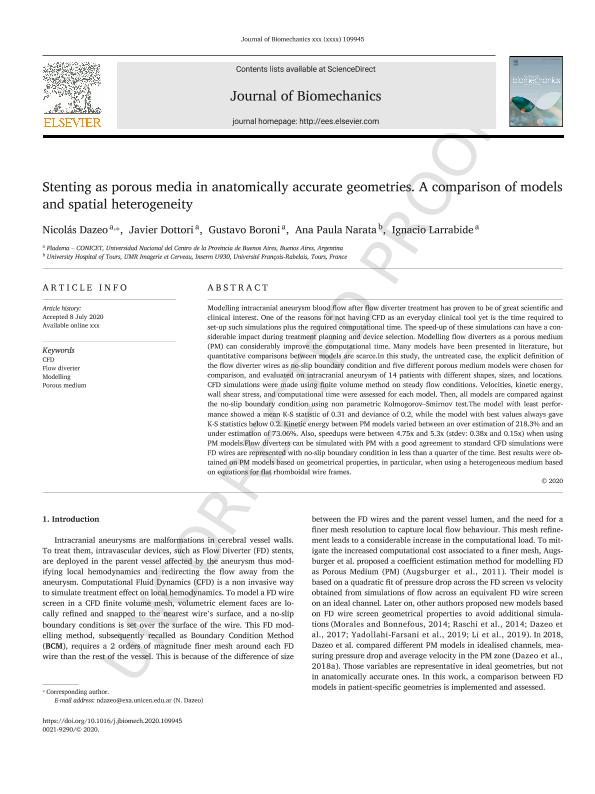Artículo
Stenting as porous media in anatomically accurate geometries: A comparison of models and spatial heterogeneity
Dazeo, Nicolás Ignacio ; Dottori, Javier Alejandro
; Dottori, Javier Alejandro ; Boroni, Gustavo Adolfo
; Boroni, Gustavo Adolfo ; Narata, Ana Paula; Larrabide, Ignacio
; Narata, Ana Paula; Larrabide, Ignacio
 ; Dottori, Javier Alejandro
; Dottori, Javier Alejandro ; Boroni, Gustavo Adolfo
; Boroni, Gustavo Adolfo ; Narata, Ana Paula; Larrabide, Ignacio
; Narata, Ana Paula; Larrabide, Ignacio
Fecha de publicación:
09/2020
Editorial:
Elsevier
Revista:
Journal of Biomechanics
ISSN:
0021-9290
Idioma:
Inglés
Tipo de recurso:
Artículo publicado
Clasificación temática:
Resumen
Modelling intracranial aneurysm blood flow after flow diverter treatment has proven to be of great scientific and clinical interest. One of the reasons for not having CFD as an everyday clinical tool yet is the time required to set-up such simulations plus the required computational time. The speed-up of these simulations can have a considerable impact during treatment planning and device selection. Modelling flow diverters as a porous medium (PM) can considerably improve the computational time. Many models have been presented in literature, but quantitative comparisons between models are scarce.In this study, the untreated case, the explicit definition of the flow diverter wires as no-slip boundary condition and five different porous medium models were chosen for comparison, and evaluated on intracranial aneurysm of 14 patients with different shapes, sizes, and locations. CFD simulations were made using finite volume method on steady flow conditions. Velocities, kinetic energy, wall shear stress, and computational time were assessed for each model. Then, all models are compared against the no-slip boundary condition using non parametric Kolmogorov–Smirnov test.The model with least performance showed a mean K-S statistic of 0.31 and deviance of 0.2, while the model with best values always gave K-S statistics below 0.2. Kinetic energy between PM models varied between an over estimation of 218.3% and an under estimation of 73.06%. Also, speedups were between 4.75x and 5.3x (stdev: 0.38x and 0.15x) when using PM models.Flow diverters can be simulated with PM with a good agreement to standard CFD simulations were FD wires are represented with no-slip boundary condition in less than a quarter of the time. Best results were obtained on PM models based on geometrical properties, in particular, when using a heterogeneous medium based on equations for flat rhomboidal wire frames.
Palabras clave:
CFD
,
FLOW DIVERTER
,
MODELLING
,
POROUS MEDIUM
Archivos asociados
Licencia
Identificadores
Colecciones
Articulos(CCT - TANDIL)
Articulos de CTRO CIENTIFICO TECNOLOGICO CONICET - TANDIL
Articulos de CTRO CIENTIFICO TECNOLOGICO CONICET - TANDIL
Citación
Dazeo, Nicolás Ignacio; Dottori, Javier Alejandro; Boroni, Gustavo Adolfo; Narata, Ana Paula; Larrabide, Ignacio; Stenting as porous media in anatomically accurate geometries: A comparison of models and spatial heterogeneity; Elsevier; Journal of Biomechanics; 110; 9-2020; 1-11
Compartir
Altmétricas



